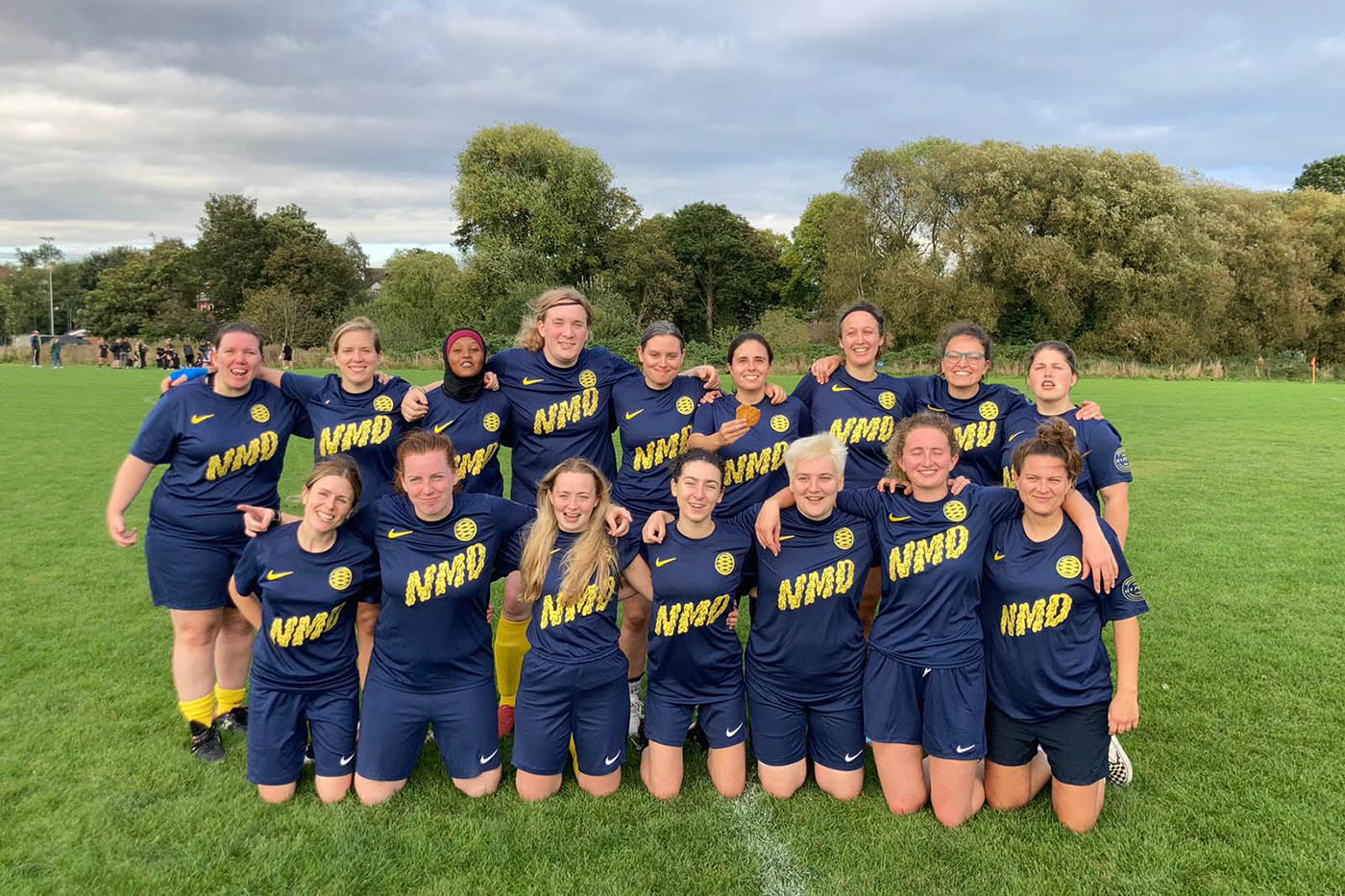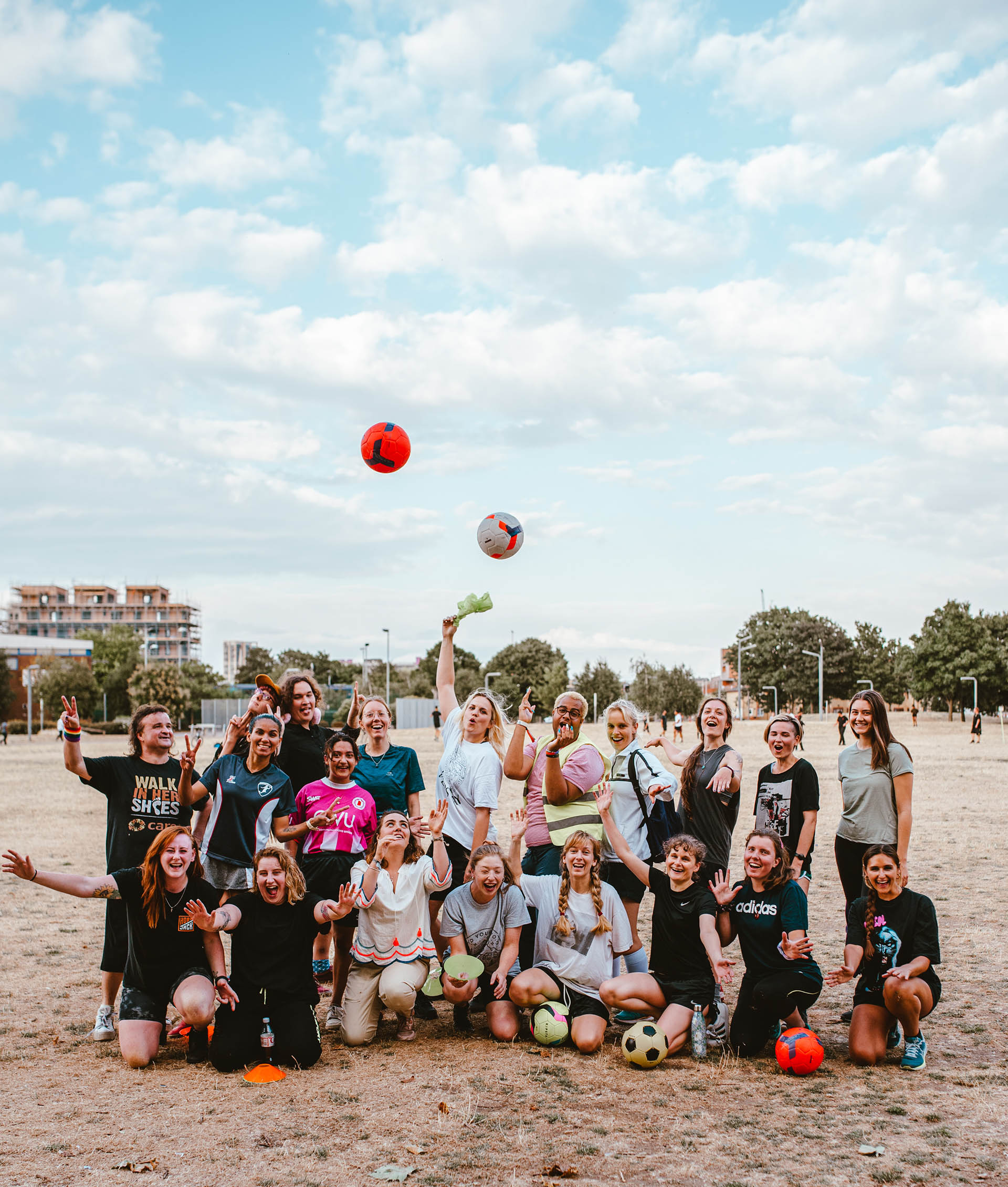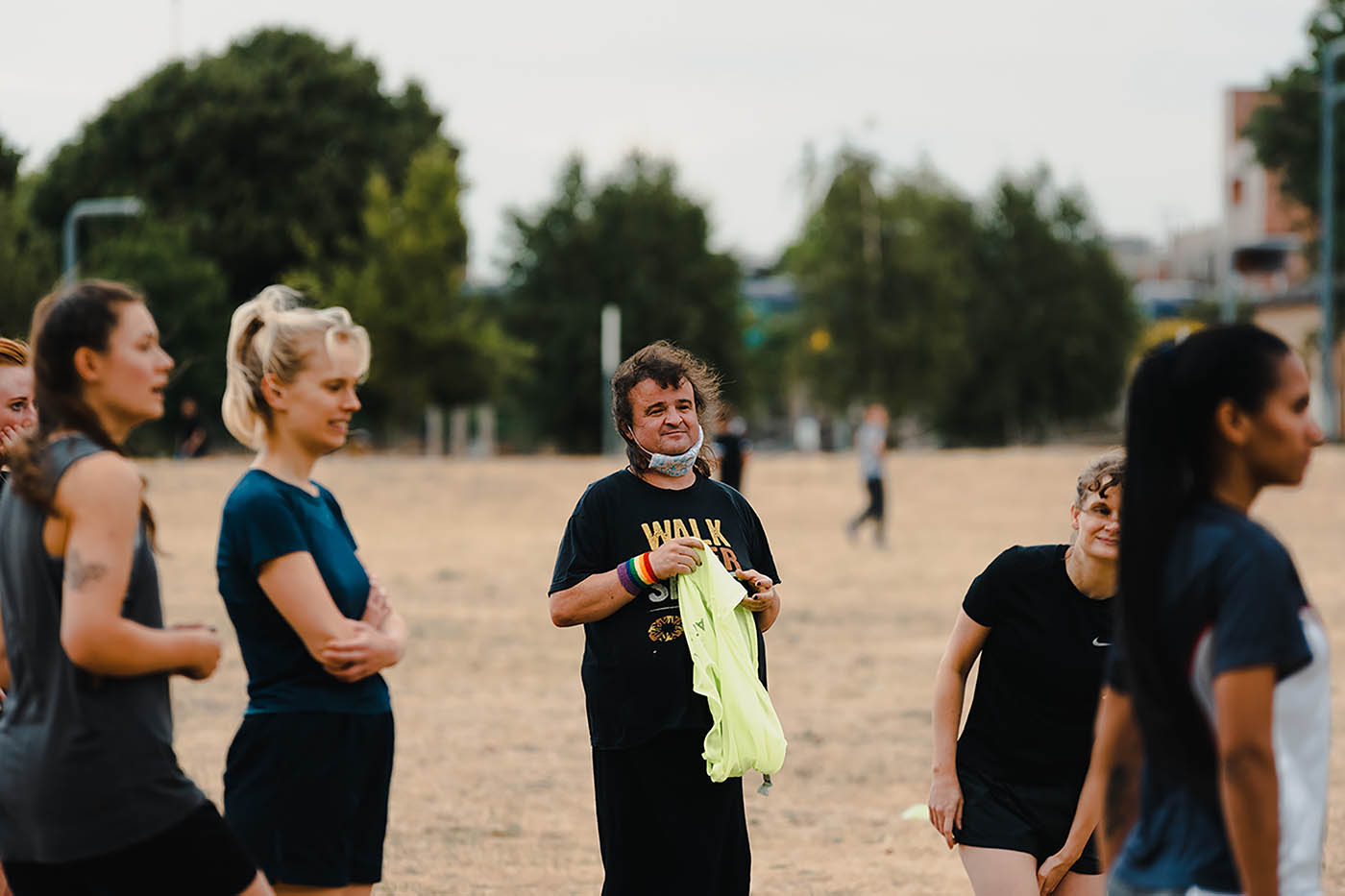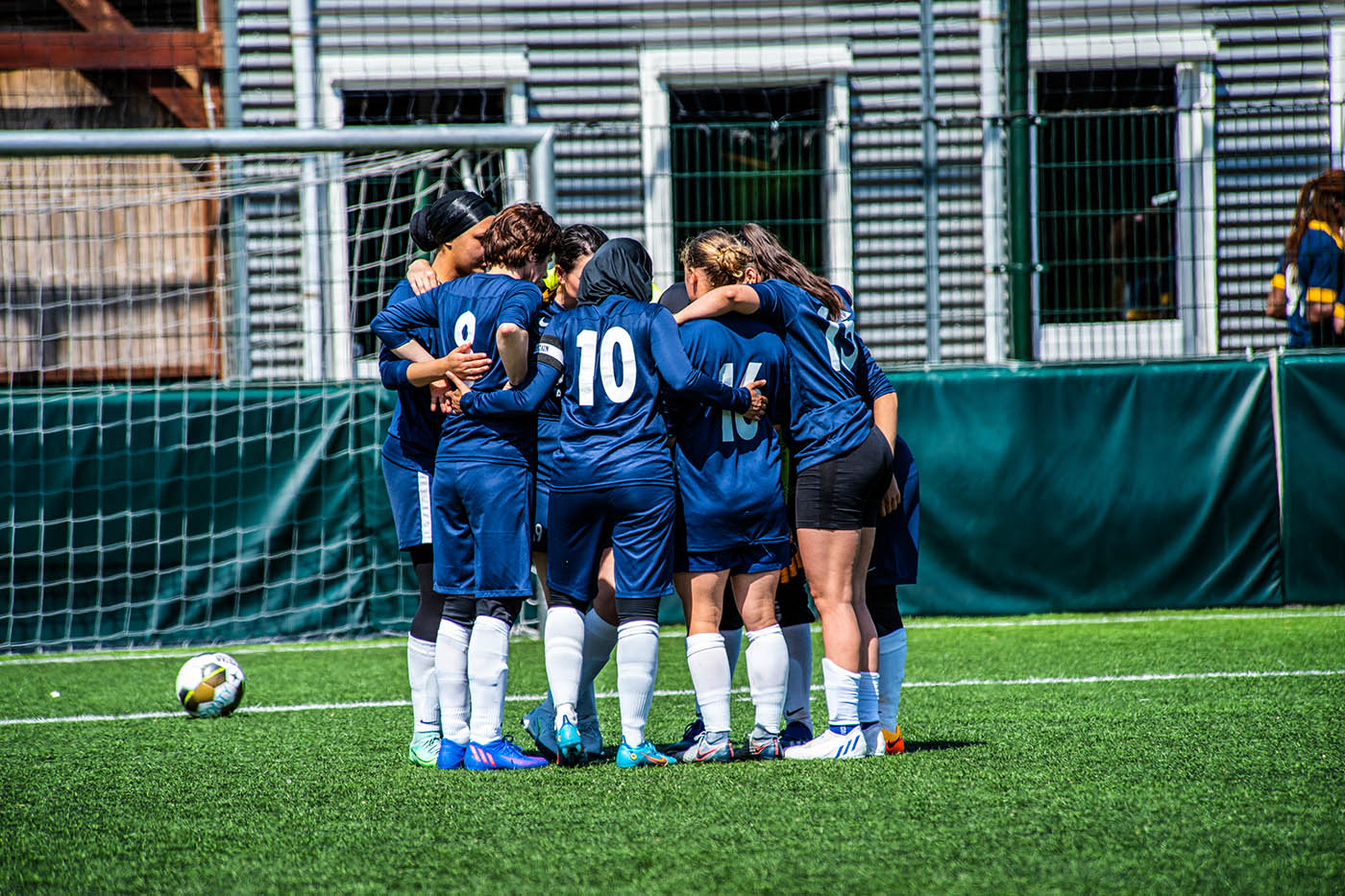
Like many casual followers of sports in the U.K., I was only faintly aware that England was due to host the Women’s Euro Cup—the main soccer tournament held between European nations every four years—this summer. Soccer was always an appealing concept, but not one I felt truly connected to—the dominance of the men’s sport, the boorishness of many fans and the absence of girls’ teams at school made it seem out-of-reach. Fast forward to today, and I’m a member of two grassroots teams. I’ve attended a quarter-final Austria-Germany Euro Cup game, and made a whole new group of friends simply by playing soccer. Watching the England Lionesses reach the finals this Sunday, when they’ll be playing in front of a sold-out 87,000-strong crowd at London’s Wembley Stadium, has made it even more memorable.
And my experience is far from unique. The tournament has coincided with a continued surge in grassroots women’s soccer participation. For many, it’s the first time they’ve ever kicked a soccer ball. For others, it’s a welcome return to a sport they abandoned as a teen given the absence of women’s teams. Tired of feeling excluded from mainstream soccer culture, these amateur players aren’t seeking to emulate the men’s sport. Instead, they’re creating radically inclusive spaces open to everyone irrespective of age, ethnicity, sexual orientation and gender identity—many players see these spaces as a safe haven at a time when transgender rights are under increasing attack.
Read More: How Trans Sports Bans Became Part of the Conservative Movement
After several waves of COVID-19 and nationwide lockdowns took her away from the sport, Helen Hardy decided in March 2021 to set up a soccer team in north-west England that would prioritize the wellbeing of women and non-binary players. “I wanted to create a space that’s really fun, where friendship and community is at the center—and football is kind of secondary,” she says. (In the U.K. and virtually everywhere else, the sport is called football.) Now, just over a year after Manchester Laces was born, the club has some 400 players. “We’re there for the lost generation, as I like to call it, the people that didn’t have access to football growing up,” she says.

This “lost generation” of female soccer players in England was no accident. In the early 20th century, women’s soccer was growing in popularity, as suffragettes and war-time munitions factory workers found freedom and camaraderie in newly established teams. Just a year after a regional match in 1920 attracted crowds topping 50,000 at Goodison Park stadium in Liverpool, England—now home to the elite men’s team Everton FC—the governing body of soccer in England, the Football Association (FA), imposed a ban on women participating that wouldn’t be lifted until 1971. The sport has taken years to recover—England has only had a fully professional women’s league since 2018.
Now, some of those players who lost out at a young age are finding a home in grassroots teams. Elizabeth Green, who is in her 50s, first got into the sport in 2019 after seeing adverts for a new women’s team in Essex, in south-east England. With Hawkwell FC, Green plays walking soccer, a variation of the sport created in 2011 as a way to widen accessibility and encourage older players to keep up the sport. The team has a range of ages and abilities, including some retired professional players. “Because you can’t run for the ball, possession is key. It’s very much like a game of chess,” Green says.
Reimagining the boys’ club
The situation for women’s soccer teams in the U.S. looks quite different. In the 2020-21 season, nearly 28,000 players across more than 1,000 teams competed in collegiate women’s soccer, according to the National Collegiate Athletic Association. And since 2016, the U.S. women’s soccer team has been generating more revenue than the men’s team—although, the players only secured equal pay in May, after winning a class action lawsuit against the U.S. Soccer Federation. Still, women’s soccer is more valued in the U.S., says sports historian Jean Williams, because the law mandated it. In 1972, the U.S. Congress passed Title IX, which banned sex discrimination in education and compelled schools to give equal resources to girls and boys’ education. “An unintended consequence of that is that they had to do the same in sports,” Williams says.

In soccer, like most sports, “it’s all about the money,” adds Williams. And the dearth of funding for women’s soccer in England has excluded people from already-marginalized backgrounds. Just three of the 23 members of the England women’s squad are players of color, compared to nearly half of the men’s squad that reached the Euro Cup 2020 final. The placement of training clubs at regional centers has often made it difficult for girls from urban or remote areas to access without parental support—typically, it was the more privileged, white amateur players who had the resources to travel. This trickled down via a “pipeline effect” into the elite teams, William says. The FA is trying to address this with strategies such as the Discover My Talent program, which allows coaches or teachers to refer promising young players to training academies.
Grassroots teams are ahead of the soccer governing body. Nearly two years ago in East London, Sabah Mahmood was recruited by a local men’s club, FC Leytonstone, to set up a girls’ soccer team, after staff noticed that girls were tagging along to the boys’ training sessions. A former professional player with Leyton Orient, Mahmood was initially reluctant to coach, but was encouraged by a friend to be “a good role model” for the local South Asian community. “Immediately, that struck a chord with me. I had played at a decent level, but that meant nothing if I wasn’t going to be able to have another 10 girls from my area do the same in the future,” she says.
Read More: How Social Media Can Tackle the Racist Abuse of Athletes
Some of the girls’ mothers have even joined the team. “It obviously allows the girls to feel a bit more at home about the whole thing, and it makes the parents understand all the good things that can come out of being part of it,” Mahmood says. Everything around the team is designed with the local community in mind—FC Leytonstone hosts alcohol-free socials, and designed an inclusive soccer kit complete with Nike hijabs for Muslim players. And four months ago, Mahmood set up a women’s team to “give the girls something to look up to. To show them it doesn’t end here,” she says. Since then, the women’s division of FC Leytonstone has competed in an international competition.

What sets grassroots women’s teams apart, players tell TIME, is the ability to shape the sport to unique cultural and social environments. Many are also parting ways with the rules and policies recommended by the FA—most notably around gender identity.
Hannah Thornley set up Camden Bells in November 2021, a women’s soccer team open to transgender and non-binary players. When the team tried to participate in an LGBTQ-friendly FA league, the Super 5, they were asked about a trans/non-binary player on their team. Thornley says organizers told her that they had to ask about the trans/non-binary player given the FA’s rules, which states that trans players’ ability to participate is assessed on a case-by-case basis that involves medical records and checking hormone levels, and takes into account the “safety” of other players.
Thornley and her teammates decided to boycott the Super 5 League following talks over these FA rules, and were surprised at the solidarity shown by other teams. “We had 103 clubs join our Zoom call [about the boycott]. We realized it isn’t just a problem that’s happening with us, it’s a wider problem, and it falls with the FA.”
The FA is “passionate about supporting and celebrating the diversity of our national game,” a spokesperson tells TIME. “Like many other national governing bodies in sport, we are currently in the process of reviewing our transgender policy for English football.”
Read More: The U.S. Women’s Soccer Team Has Signed a Historic Equal Pay Agreement. Here’s How It Happened
However, there is skepticism that the FA will fully embrace trans players. “Gender binaries are constructed, and in sport, they’re heavily policed,” says Williams. “The football authorities want this gender binary, because they always want to position women’s sport in a secondary position to men, because that’s the logic that they’ve operated with for 150 years.”

Welcoming trans players
The issue of transgender participation in sports is a divisive topic around the globe—the world governing bodies for rugby and swimming recently introduced heavy restrictions on transgender athletes. In the U.K., the ongoing Conservative leadership contest—which will determine the country’s next prime minister following Boris Johnson’s resignation—has been marked by increasingly hardline rhetoric towards trans people. Former finance minister Rishi Sunak is expected to unveil a manifesto opposing trans women competing in women’s sport. His opponent, former women’s minister Liz Truss, has previously criticized proposals to legalize gender self-identification.
Still, grassroots soccer teams are providing a space built for and by the people it represents. Camden Bells’ Thornley, angered by the team’s experience with the FA, set up a trans-inclusive league called Clubs United in April. Eight grassroots teams have competed in the league’s first, successful season. The reaction to it, Thornley says, has been “amazing… the amount of trans and non-binary people who come each week and say that the space feels truly inclusive and safe for them to play is just gorgeous.”

One of those players is Alexandria Hassett, whom I met playing at my local team, the Deptford Ravens. She is also a member of another trans-inclusive team, Queer Space FC, that won the Clubs United league. Until recently, Hassett hadn’t played for 15 years—when she transitioned aged 27, she worried that she wouldn’t be accepted in the “male-dominated” environment of soccer. Now that she’s found an inclusive space, she says she’s “got the bug back.”
“One thing I lost when I transitioned which I’ve regained is the shooting accuracy,” she says. “I could never mark or tackle anyway, so you can’t lose what you never had. But I’ve always had the touch and that just never went. It’s like riding a bike.” Apart from her shooting ability, Hassett prides herself on her one-liner jokes, which she practices on her teammates. “It’s just great to have a team of mostly girls and non-binary pals,” she says. “Just the camaraderie it brings.”
Even with all the excitement around England women’s team heading into the Euro Cup final, there is still more to do before the sport becomes fully inclusive. But while soccer’s governing bodies “catch up with society,” says historian Williams, grassroots teams are bridging that gap—providing the vital support for minorities that is lacking in the U.K., both on and off the pitch. After 50 years of being excluded from the sport, women and non-binary players are reshaping soccer in their own image. “We can just build it ourselves, right?” says coach Mahmood.

More Must-Reads From TIME
- The 100 Most Influential People of 2024
- Coco Gauff Is Playing for Herself Now
- Scenes From Pro-Palestinian Encampments Across U.S. Universities
- 6 Compliments That Land Every Time
- If You're Dating Right Now , You're Brave: Column
- The AI That Could Heal a Divided Internet
- Fallout Is a Brilliant Model for the Future of Video Game Adaptations
- Want Weekly Recs on What to Watch, Read, and More? Sign Up for Worth Your Time
Contact us at letters@time.com